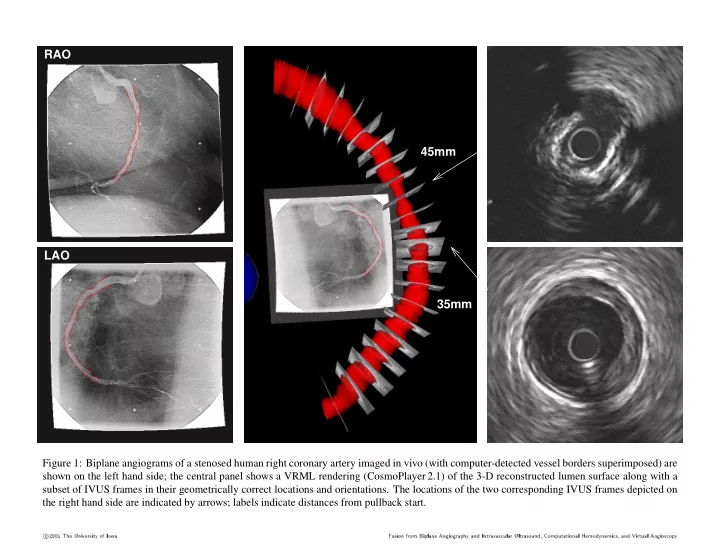

RAO 45mm LAO 35mm Figure 1: Biplane angiograms of a stenosed human right coronary artery imaged in vivo (with computer-detected vessel borders superimposed) are shown on the left hand side; the central panel shows a VRML rendering (CosmoPlayer 2.1) of the 3-D reconstructed lumen surface along with a subset of IVUS frames in their geometrically correct locations and orientations. The locations of the two corresponding IVUS frames depicted on the right hand side are indicated by arrows; labels indicate distances from pullback start. c � 2001 The Universit y of Io w a F usion from Biplane Angiography and Intravascula r Ultrasound, Computational Hemo dynamics, and Virtual Angioscop y
High shear stress Negative shear stress Figure 2: Reconstructed right coronary artery from Figure 1 after computational hemodynamics analysis; red color indicates high shear stress, green color normal shear stress, and blue color reverse flow. c � 2001 The Universit y of Io w a F usion from Biplane Angiography and Intravascula r Ultrasound, Computational Hemo dynamics, and Virtual Angioscop y
Figure 3: Endoscopic view from the most distal end towards the proximal end for the artery shown in Figure 1; IVUS frames are displayed in semi-transparent mode with catheter removed. c � 2001 The Universit y of Io w a F usion from Biplane Angiography and Intravascula r Ultrasound, Computational Hemo dynamics, and Virtual Angioscop y
Figure 4: The IVUS data is represented as semi-transparent frames; the pyramid indicates the current location of the observer at the stenosis, which can be easily identified from the bright IVUS echoes with high opacity. c � 2001 The Universit y of Io w a F usion from Biplane Angiography and Intravascula r Ultrasound, Computational Hemo dynamics, and Virtual Angioscop y
Figure 5: Virtual angioscopy with VRML/JavaScript control panel inserted; current viewing mode shows the lumen surface rendered in red color; the observer is located approximately at the 35 mm position viewing in proximal direction towards the 45 mm position, as indicated in Figure 1. c � 2001 The Universit y of Io w a F usion from Biplane Angiography and Intravascula r Ultrasound, Computational Hemo dynamics, and Virtual Angioscop y
Figure 6: Same position and view as for Figure 5, with shear stress data from Figure 2 included; the low shear stress (green) and turbulences (blue) distal of the stenosis (in front of this view) are clearly depicted, as well as increasing shear stress (yellow–red) within the stenosis. c � 2001 The Universit y of Io w a F usion from Biplane Angiography and Intravascula r Ultrasound, Computational Hemo dynamics, and Virtual Angioscop y
Recommend
More recommend